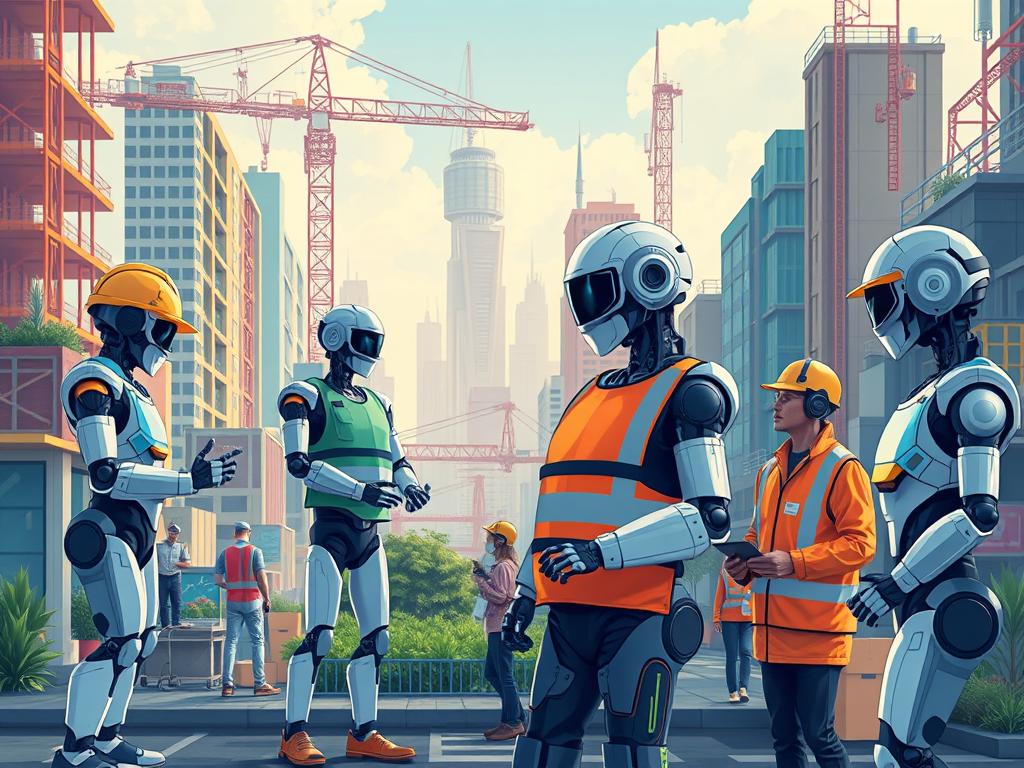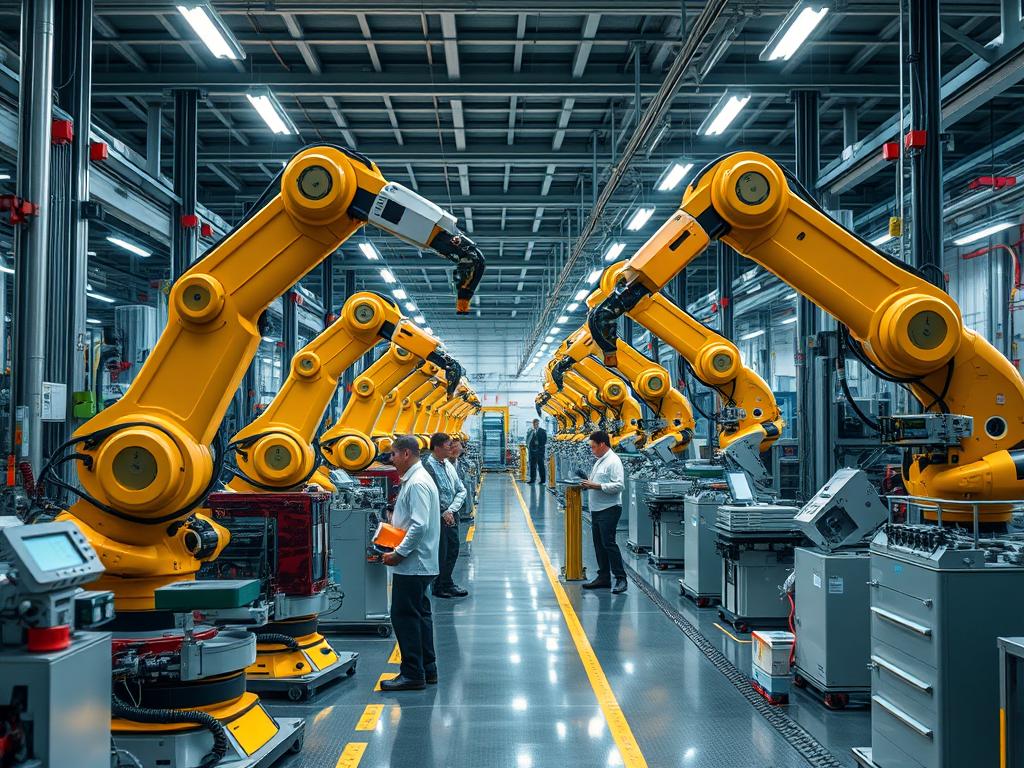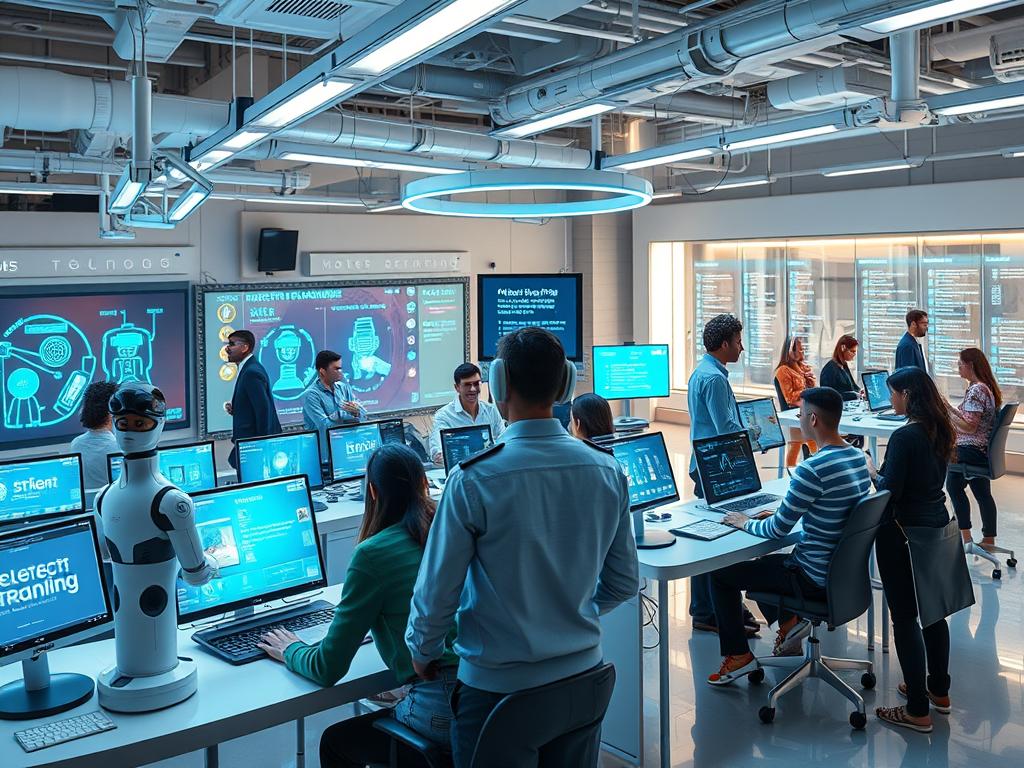Did you know that the rise of robots in the workforce is projected to increase productivity by up to 30% in the automotive industry alone? As we stand on the brink of a technological revolution, understanding how robots will affect the job market in the future becomes crucial. The integration of automation technologies is not just a trend; it represents a significant turning point for employment across various sectors.
This article delves into the intricate relationship between automation and job market trends, examining the potential benefits alongside the drawbacks. With robots increasingly stepping into roles traditionally held by humans, it raises questions about displacement vs. job creation and what the transformation of skill requirements will look like moving forward.
Moreover, sectors like manufacturing, healthcare, and logistics are experiencing unprecedented changes, with robots enhancing efficiency and reducing operational costs. However, this shift also demands careful consideration. As we explore this evolving landscape, it will be essential to develop policies that address the balance between technological advancement and workforce stability. For example, the integration of VR and AR technologies in showcases how innovation can complement human roles rather than replace them.
Key Takeaways
- The automotive industry is projected to see a 30% rise in productivity due to robotics.
- Robotic solutions can reduce production costs in manufacturing by about 22%.
- Healthcare robotics adoption is expected to grow by 20% annually.
- Robotics can increase order fulfillment rates in logistics by 10%.
- Displacement of certain jobs raises concerns about economic inequality.
- Investing in reskilling and upskilling programs remains critical for workers.
- The emergence of new job categories is evident across various sectors.
Introduction to Robots in the Workforce
The integration of robots into the workforce has evolved significantly through the years, influenced by numerous automation technologies that enhance productivity and efficiency. As businesses adopt these innovations, understanding the history of automation provides valuable insight into the fundamental changes shaping today’s work environments.
Overview of Automation Technologies
Modern automation technologies encompass a variety of tools and systems designed to streamline tasks and processes. These include industrial robots utilized for manufacturing, collaborative robots (cobots) that work alongside humans, and advanced software systems that manage operations. Such technologies are particularly prevalent in industries like automotive, warehousing, and electronics, showcasing their versatility across different sectors.
Historical Context of Automation
The history of automation traces back to the Industrial Revolution, which heralded the beginning of mechanization and mass production. Significant milestones, such as the installation of General Motors’ Unimate robot in 1959, marked pivotal moments in how tasks could be performed by robots. Over decades, robotic adoption flourished, reaching a point where, by 2007, the U.S. saw an increase of industrial robots fourfold, demonstrating the profound role of technology in reshaping workplaces.
The Role of Artificial Intelligence
Artificial intelligence significantly enhances the role of AI in the workforce by enabling robots to perform complex tasks with more autonomy and intelligence. AI systems allow for improved decision-making capabilities within robots, leading to increased efficiency and adaptability in various operations. This transformation goes beyond traditional automation, ushering in a new era where robotic systems learn and evolve based on their experiences.
How Robots Are Changing Job Dynamics
The introduction of robots into the workforce is altering job dynamics significantly across various industries. This transformation invites both challenges and opportunities, prompting an examination of how job displacement and job creation trends unfold. As companies embrace advanced automation technologies, the nature of work is shifting, necessitating a reevaluation of skills and requirements.
The Nature of Work in Various Industries
Different sectors are experiencing unique effects due to automation. For instance, the automobile industry has a high concentration of robots, with 629 robots employed per 10,000 workers, while the food and beverages industry runs on just 74. This discrepancy in robot adoption leads to various job dynamics with robots and impacts how work is perceived and performed within those sectors. Notably, a rise in automation correlates with a decline in work meaningfulness and autonomy for many, particularly those engaged in repetitive tasks.
Job Displacement vs. Job Creation
Job displacement remains a critical concern as advancements in robotics and artificial intelligence threaten to eliminate millions of positions across numerous professions, including healthcare, retail, and accounting. Research indicates that while some workers experience job displacement due to automation, significant job creation trends emerge in new sectors requiring advanced skill sets. Workers capable of complementing automation through technological skills frequently find enhanced compensation, presenting a path forward amid the challenges posed by robot adoption.
The Transformation of Skill Requirements
The skills transformation due to automation requires a strategic response from educational institutions and policymakers. Workers, particularly those without postsecondary education, may face disadvantages in the evolving job market. Enhanced training and support systems are essential to help displaced workers acquire new competencies suitable for emerging roles. This shift not only reflects the urgent need for improved educational frameworks but also emphasizes the importance of lifelong learning in adapting to new technologies. Addressing these skill gaps is crucial for ensuring that the benefits of automation are widely shared and do not exacerbate income inequality.

Benefits of Robotics in the Workplace
The integration of robotics within various industries provides numerous advantages that enhance productivity and safety. Adopting such technology not only improves efficiency but also contributes positively to the overall workplace environment. Understanding these benefits can help businesses thrive in an increasingly competitive market.
Increased Efficiency and Productivity
Utilizing robotics leads to significant efficiency improvements in diverse operations. For instance, the automotive industry accounts for about 30% of total robotization demand annually. An Autonomous Mobile Robot (AMR) can work full shifts, maintaining production round-the-clock. With more than 5,000 Robotnik mobile robots currently in use, organizations are optimizing processes effectively. This technology allows companies to produce more while reallocating human resources towards complex tasks.
Reducing Human Error
Robotics play a crucial role in minimizing human error in production and operational settings. By automating repetitive and data-intensive tasks, organizations significantly reduce the likelihood of mistakes. This enhancement in performance not only boosts output but also ensures high-quality results, contributing to business competitiveness. The introduction of collaborative robots allows seamless interaction with human workers, enhancing workflows and overall efficiency.
Enhancing Safety in Hazardous Environments
Workplace safety with robots has become a top priority, especially in industries such as manufacturing and healthcare. By deploying robots to handle dangerous tasks, companies can protect their workforce from potential injuries. Recent statistics indicate that the healthcare sector consumes over 10% of GDP; thus, improving operational safety can lead to increased production margins. Businesses adopting robotics demonstrate a commitment to safeguarding their employees and optimizing their operations.
| Benefit | Details |
|---|---|
| Efficiency Improvements | Robots enable continual production without breaks, offering 24-hour operation. |
| Reduction of Human Error | Automation decreases mistake rates, improving product quality and output consistency. |
| Enhanced Safety | Robots are used in hazardous roles to protect human workers from injury, particularly in manufacturing. |
| Job Creation | The robot industry generates significant employment opportunities, counterbalancing job displacement in other areas. |
For those interested in exploring the future of technology in the workplace, numerous resources are available. Embracing the benefits of robotics can lead to a transformation that not only improves operational efficiency but also paves the way for a safer, more productive working environment. Discover more about this integration process by visiting transformative strategies for businesses.
Sectors Most Affected by Robotics
The rise of robotics is ushering in transformative changes across various sectors. Particularly notable are the impacts seen in manufacturing, healthcare, and transportation. As businesses evolve, understanding the effects of automation can provide insight into future employment trends.
Manufacturing and Production Jobs
Manufacturing automation has revolutionized production lines, allowing companies to enhance efficiency and reduce costs. Robots excel in repetitive tasks like sorting raw materials and stocking supplies. This shift enables higher-skilled workers to focus on complex operations requiring critical thinking and problem-solving abilities. Researchers estimate that anywhere from 9% to 47% of jobs in manufacturing could face automation in the coming years. Adopting robotics in this sector not only boosts productivity levels but can also contribute to an increase in gross domestic product (GDP).
Healthcare and Robotics Integration
Healthcare robotics are increasingly integrated into clinical practices, enhancing patient care and surgical precision. Robots assist in tasks ranging from patient transport to complex surgeries, ensuring higher accuracy and reduced recovery times. The demand for technical expertise in healthcare robotics continues to rise, highlighting the need for specialized training. Workers equipped with process skills and technical knowledge are more likely to thrive in an industry evolving with robotic technology. As healthcare automation progresses, training programs must prioritize in-demand skills to minimize job displacement impacts.
Transportation and Delivery Services
Transportation automation is rapidly changing the logistics landscape. Innovations such as drones and self-driving vehicles are revolutionizing delivery systems, presenting both opportunities and challenges. Automation in this sector can enhance efficiency in travel and logistics but also poses a risk of job losses among drivers and related professions. As the sector adapts, training initiatives should focus on equipping workers with the necessary interpersonal skills and technical expertise to transition into new roles that robotic technologies create. Understanding the dynamics of sectors impacted by robotics is crucial for preparing a workforce ready to meet future demands.

| Sector | Impact of Robotics | Skills in Demand |
|---|---|---|
| Manufacturing | Increased efficiency through automation | Technical expertise in equipment maintenance |
| Healthcare | Enhanced patient care and surgical precision | Advanced process skills for adapting to new tools |
| Transportation | Evolution through the use of drones and self-driving vehicles | Interpersonal skills for customer interaction |
For further insights into the workforce changes driven by robotics and AI, visit this article.
The Future Job Market Landscape
The ongoing changes in technology and employment dynamics promise to reshape the workplace in unprecedented ways. As businesses increasingly integrate robots and automation, the future job market predictions suggest significant shifts in employment structures. Experts are divided on the extent of these changes, yet consensus exists on the emergence of new job categories due to automation, alongside evolving gig economy trends.
Predictions for Employment Shifts
Approximately 48% of experts believe that robotics and artificial intelligence will significantly displace workers across various sectors by 2025. Yet, 52% maintain that technological advancements will not eliminate more positions than they create. Concerns around income inequality and social unrest remain prominent, reflecting broader worries related to job displacement.
New Job Categories Emerging
As barriers fall and automation spreads, specific skills will become paramount. Fields like programming, data analysis, and robotics are projected to gain immense value, leading to new job categories that prioritize creativity and critical thinking. Employment in science, technology, engineering, and math (STEM) is forecasted to thrive, demonstrating resilience against automation.
The Rise of Remote and Gig Work
The gig economy continues to adapt to automation, allowing for more flexible job structures. Companies are increasingly leveraging remote work, facilitated by technology. A report from Goldman Sachs highlights that automation may impact around 300 million jobs globally within the next decade. As individuals prepare for these shifts, remaining adaptable will be crucial to navigating the evolving future job market.
Reskilling and Upskilling Workers
The rapid integration of technology in the workforce necessitates a strong emphasis on workforce reskilling and upskilling. The importance of lifelong learning has never been more critical as employees must adjust to an evolving job market shaped by automation and artificial intelligence. Organizations and educational institutions are stepping up to the challenge, offering programs that prepare workers for future job demands.
Importance of Lifelong Learning
Lifelong learning importance is paramount in an age where 50% of current job tasks are projected to be automated. The World Economic Forum indicates that by 2025, over half of all professions will require reskilling or upskilling due to technological advances. Workers must embrace continuous education to remain relevant and competitive, as roles traditionally performed by humans are increasingly taken over by machines.
Programs and Initiatives for Workforce Development
Various educational initiatives for automation have emerged to address the skills gap in today’s labor market. Examples include:
- Online courses offered by platforms like Coursera and Udacity focusing on AI and data science.
- Partnerships between corporations and training organizations, like Amazon’s reskilling of over 2,000 employees in machine learning skills.
- Community colleges providing targeted certificate programs in advanced manufacturing technologies.
Role of Educational Institutions
Educational institutions play a pivotal role in workforce reskilling and upskilling through innovative programs. They are responding to industry needs by:
- Developing curricula that integrate emerging technologies and soft skills essential for the modern workplace.
- Collaborating with businesses to create hands-on training opportunities that reflect real-world scenarios.
- Encouraging an ecosystem of lifelong learning that supports ongoing career advancement and adaptation to change.

The Debate on Universal Basic Income
The universal basic income debate has gained significant traction in recent years, particularly as automation reshapes the workforce. Advocates and critics discuss the viability and implications of UBI, weighing its potential benefits against possible downsides. The conversation often revolves around the UBI pros and cons, exploring the intricacies of this policy as a response to job displacement caused by technological advancements.
Pros and Cons of UBI
Supporters of UBI argue that it could provide essential financial stability for displaced workers, fostering a safety net in a rapidly changing job market. Critics, on the other hand, raise concerns about the sustainability of such a program and its ability to encourage workforce participation. The ongoing universal basic income debate emphasizes the need for a balanced approach, reflecting on both positive outcomes and potential drawbacks.
Historical Experiments and Their Findings
Historically, experiments in countries like the Netherlands and Kenya have explored the effects of UBI on the labor market. In the Netherlands, a study from 2017 to 2019 indicated that individuals receiving a basic income showed increased engagement in employment. Similarly, the Kenyan UBI initiative has stimulated entrepreneurship and impacted salaries, proving insightful for future implementations. These findings contribute to understanding the economic impact of UBI and its role in modern economies.
Potential Impact on the Economy
The economic impact of UBI has become a focal point of the conversation. Proponents suggest that UBI could drive consumer spending, thus stimulating job creation. Despite the optimistic perspective, experts warn against solely correlating UBI with automation, highlighting the need to address broader issues like inequality and wage stagnation. Therefore, the universal basic income debate unfolds across various dimensions of economic stability and social welfare.
Conclusion: Balancing Technology and Humanity
As we navigate the evolving landscape of employment shaped by advancements in robotics and artificial intelligence, it is essential to strike a balance between technological innovation and the human element in the workplace. Developing ethical guidelines for automation is a vital step in ensuring that these technologies work for humanity rather than against it. This framework will help mitigate job displacement concerns while addressing the ethical implications of automation in various sectors.
The Need for Ethical Guidelines
Establishing these ethical guidelines can provide a structured approach to integrating robots into workflows. By doing this, we can prepare for a collaborative workforce future, where machines and humans not only coexist but thrive together. This future demands transparency and accountability in how technologies are developed and implemented, ensuring that the workforce is equipped to adapt and grow.
Preparing for a Collaborative Future
In a world where automation will potentially replace millions of jobs, it is crucial to foster an environment that emphasizes human-centric work models. By focusing on soft skills and continuous learning, we empower individuals to engage meaningfully in their roles. This shift towards cultivating unique human traits such as creativity, empathy, and strategic thinking will be essential for maintaining job satisfaction and productivity.
Emphasizing Human-Centric Work Models
Ultimately, the future of work necessitates a commitment to reshaping our approaches. Emphasizing strategies that prioritize human well-being alongside technological growth provides a sustainable pathway forward. A thoughtful approach to integrating automation while fostering a collaborative environment can lead to a workforce that adapts, thrives, and becomes more resilient in the face of change.











